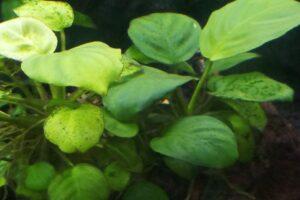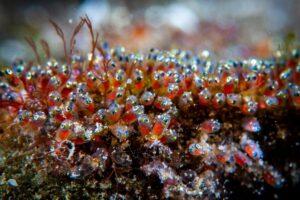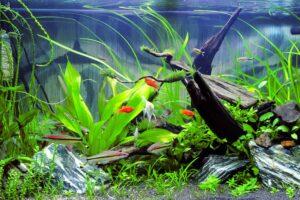Neon Tetras (Paracheirodon innesi) are captivating and vibrant freshwater fish that originate from the blackwater regions of South America, specifically the Amazon basin. Their popularity in the aquarium hobby stems from their stunning coloration, which consists of a vibrant blue horizontal stripe that runs along their midsection, separated by a striking red stripe beneath. The combination of these colors creates a mesmerizing contrast that captures the attention of aquarists worldwide. As it is so easy to maintain, no wonder it’s regarded as one of the best aquarium fish for beginners.
In their natural habitat, Neon Tetras inhabit slow-moving waters with tannins and decaying vegetation, resulting in characteristic blackwater conditions. These conditions are known for their soft, slightly acidic water with low mineral content. Replicating these conditions in the aquarium can help create an environment that closely resembles their native habitat and promotes their overall well-being.
Neon Tetras have a small and delicate body, typically growing to a size of around 1 to 1.5 inches (2.5 to 3.8 cm). Despite their small size, their vibrant colors and peaceful nature make them a highly sought-after species in the aquarium trade. They are widely regarded as an excellent choice for community aquariums due to their non-aggressive behavior and compatibility with a variety of other small, peaceful fish species.
Table of Contents
ToggleNeon Tetra Care
To provide optimal care for Neon Tetras, it is crucial to ensure a suitable aquarium setup. A tank size of at least 10 gallons is recommended to accommodate a group of Neon Tetras comfortably. Providing a secure lid is important as these fish are known to be skilled jumpers. Implementing efficient filtration and performing regular water changes will help maintain excellent water quality, which is crucial for the health and longevity of Neon Tetras.
Water parameters play a vital role in Neon Tetra care. They thrive in slightly acidic to neutral water with a pH range of 6.0 to 7.5. A stable water temperature of 72-78°F (22-26°C) is optimal, and maintaining soft to moderately hard water (dH 4-10) is preferred. You can use water softeners like API WATER SOFTENER PILLOW and high-quality water conditioners like the API TAP WATER CONDITIONER to ensure a healthy aquatic environment.
In terms of diet, Neon Tetras are omnivorous and will readily accept high-quality flake or pellet food formulated for small tropical fish. Supplementing their diet with occasional live or frozen foods like brine shrimp, daphnia, or bloodworms will provide them with additional nutrients and promote their natural foraging behavior. Ultra Fresh Tetra Fish Food has been one of our favorite. It is important to feed them in small amounts multiple times a day to prevent overfeeding and maintain good water quality.
Aquascaping the tank with suitable vegetation and providing hiding places is beneficial for Neon Tetras. Dense plants like Java Moss, Java Fern, Amazon Sword, and Water Sprite mimic their natural habitat, provide security, and create visually appealing environments. Floating plants can help diffuse the lighting, creating a more subdued and natural lighting effect, which Neon Tetras appreciate.
Keeping Neon Tetras in groups of six or more is highly recommended. They are shoaling fish by nature, and being in a group helps reduce stress and encourages natural behavior. Additionally, a larger group of Neon Tetras enhances the visual impact of their vibrant colors and makes for a more captivating display in the aquarium.
Regular observation of Neon Tetras is important to ensure their well-being. Any signs of abnormal behavior, loss of appetite, or color fading should be investigated promptly as they may indicate underlying health issues. Quarantining new fish before introducing them to the main tank is a good practice to prevent the spread of diseases.
By providing suitable conditions, a well-maintained aquarium, and a balanced diet, you can enjoy the beauty and peaceful presence of Neon Tetras in your aquatic world. Their vibrant colors and graceful swimming patterns will undoubtedly bring joy and tranquility to your aquarium.

Additional Tips
Here are some additional tips to enhance your Neon Tetra care:
1. Tank Mates: Neon Tetras are peaceful and social fish that thrive in the company of their own species and other compatible tank mates. Consider adding other small, non-aggressive species such as Corydoras catfish, Dwarf Gouramis, peaceful rasboras, or small tetras to create a harmonious community.
2. Water Quality Maintenance: Along with regular water changes, it’s important to test the water parameters regularly using reliable test kits. This will help you monitor the levels of ammonia, nitrite, nitrate, and pH to ensure a stable and healthy environment for your Neon Tetras.
3. Acclimation: When introducing Neon Tetras to your aquarium, it is crucial to acclimate them slowly to minimize stress and potential health issues. Float the bag containing the fish in the tank for about 15-20 minutes to allow the water temperatures to equalize. Then, gradually add small amounts of tank water to the bag at regular intervals before gently releasing them into the aquarium.
4. Breeding Considerations: Breeding Neon Tetras can be a rewarding experience. However, it requires specific conditions, such as slightly acidic and soft water, and a separate breeding tank with suitable spawning media, like fine-leaved plants or a mesh breeding box. Providing a well-balanced diet and maintaining optimal water conditions can encourage spawning behavior.
5. Tank Lighting: Neon Tetras tend to display their vibrant colors more prominently under subdued lighting conditions. Avoid excessively bright or harsh lighting, as it can cause stress and may fade their colors over time. Opt for adjustable or dimmable lights to create a natural and visually pleasing environment for your fish. We covered some of the best aquarium lights for your review.
6. Disease Prevention: To minimize the risk of diseases, practice good aquarium hygiene. Regularly clean the substrate, remove debris, and maintain clean filters. Avoid introducing new fish without proper quarantine and ensure that any new additions to the tank come from reputable sources.
7. Enjoy their Natural Behavior: Neon Tetras are active and playful swimmers. Observe their shoaling behavior, as they tend to swim together in synchronized movements. Providing ample swimming space and a well-decorated tank with hiding places will encourage their natural behavior and reduce any potential stress.
Remember, patience and consistency are key when caring for Neon Tetras. By creating an environment that mimics their natural habitat, maintaining optimal water conditions, and offering a balanced diet, you can ensure the long-term health and well-being of these captivating fish. The beauty and elegance of Neon Tetras will continue to captivate both beginners and experienced aquarists alike, making them a timeless favorite in the aquarium hobby.
FAQs
1. What is the best food for neon tetras?
The best food for Neon Tetras is a varied diet consisting of high-quality flake or pellet food specifically formulated for small tropical fish. They are omnivorous and will also benefit from occasional feedings of live or frozen foods like brine shrimp, daphnia, or bloodworms to provide essential nutrients.
2. What are the best plants for neon tetras?
Ideal plants for Neon Tetras include dense, leafy plants such as Java Moss, Java Fern, Amazon Sword, and Water Sprite. These plants offer hiding places, security, and mimic their natural habitat, while also providing a source of food and oxygen for the fish.
3. What is the best temperature for neon tetras?
Neon Tetras prefer a temperature range of 72-78°F (22-26°C). Keeping the aquarium water within this range helps maintain their health, vibrant colors, and promotes their overall well-being.
4. Can neon tetras live with bettas?
Neon Tetras should not be kept with bettas (Siamese fighting fish) as bettas have a tendency to nip at the long, flowing fins of Neon Tetras. This can cause stress, injury, and potential fatalities for the Neon Tetras.
5. Can neon tetras live with goldfish?
It is not recommended to keep Neon Tetras with goldfish. Goldfish thrive in cooler water temperatures, while Neon Tetras prefer warmer temperatures. Additionally, goldfish have a tendency to be more active and can accidentally harm the delicate Neon Tetras.
6. How long do neon tetras live?
Neon Tetras have an average lifespan of about 3-5 years. Providing them with proper care, a suitable environment, and a balanced diet can contribute to their longevity.
7. How often should I feed neon tetras?
Neon Tetras should be fed small amounts of food 1-2 times a day. It is important to offer them an amount they can consume within 2-3 minutes to avoid overfeeding and water quality issues.
8. What are the types of neon tetras?
There are different varieties of Neon Tetras, including the common Neon Tetra (Paracheirodon innesi) with its blue and red stripes, as well as variations such as the Diamond Neon Tetra and the Longfin Neon Tetra that have slight differences in fin shape or color intensity.
9. How long do neon tetras live?
Neon Tetras typically have a lifespan of around 3-5 years, although some individuals may live longer with proper care, suitable water conditions, and a balanced diet.
10. What do neon tetras eat?
Neon Tetras are omnivorous and their diet primarily consists of high-quality flake or pellet food specifically formulated for small tropical fish. They can also consume small live or frozen foods such as brine shrimp, daphnia, or bloodworms.
11. Are neon tetras hardy?
Neon Tetras are considered relatively hardy fish, but they still require proper care. They can adapt to a variety of water conditions, but they are sensitive to sudden changes, so maintaining stable water parameters and regular maintenance is important for their well-being.
12. How many neon tetras should I keep?
A general guideline is to keep Neon Tetras in groups of at least 6 individuals or more. They are shoaling fish, and being in a group helps reduce stress and encourages natural behavior and vibrant colors.
13. Will neon tetras breed in a community tank?
Neon Tetras can breed in a community tank, but the survival rate of the fry (baby fish) may be lower as other fish in the tank might prey on them. If you want to breed Neon Tetra, ensure enough plants for hiding places and keep mainly just the peaceful fishes and if possible, just neon tetras alone.
14. Will neon tetras eat cherry shrimp?
Neon Tetras generally do not pose a threat to adult Cherry Shrimp. However, there is a possibility that they may consume shrimp fry (baby shrimp) if given the opportunity. It is recommended to provide hiding places or dense vegetation for the shrimp to seek refuge in order to increase their chances of survival in a tank with Neon Tetras.
15. How do neon tetras sleep?
Neon Tetras do not have eyelids and do not sleep in the same way humans do. They exhibit a resting behavior where they become less active and may position themselves near plants or other structures in the tank. They may also display a slight decrease in movement during the nighttime hours.
16. What is neon tetra disease?
Neon Tetra Disease is a highly contagious condition caused by a parasitic organism. It primarily affects Neon Tetras and can result in symptoms such as loss of color, appetite, and body deformities. Unfortunately, there is no known cure for this disease, and infected fish should be isolated and removed from the tank to prevent spreading it to other fish.
17. Are neon tetras tropical fish?
Yes, Neon Tetras are tropical fish. They originate from the warm, slow-moving waters of South America, specifically the Amazon basin. Therefore, they require consistent tropical temperatures and prefer soft and slightly acidic water conditions to thrive.
18. Why is my neon tetra losing color?
There can be several reasons why a Neon Tetra may be losing its color. Stress, poor water quality, improper diet, or underlying health issues can all contribute to a loss of coloration. Ensuring appropriate water parameters, a balanced diet, and a stress-free environment can help maintain their vibrant colors.
19. Why do neon tetras chase each other?
Neon Tetras may chase each other for various reasons, including establishing dominance within the group, courtship behavior, or territorial disputes. It is a natural behavior among shoaling fish and can be observed during certain periods or triggered by specific environmental factors.
20. Are neon tetra fish aggressive?
Neon Tetras are generally peaceful and not aggressive. They are known for their calm and shoaling nature. However, occasional fin-nipping or chasing behavior may occur within their own species or towards other fish if they feel threatened or if there is limited space in the tank. Providing ample swimming space and suitable group size can help minimize aggression and promote harmonious coexistence.









